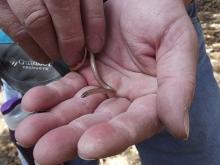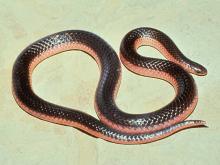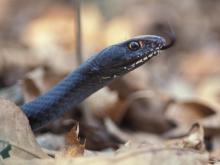Reptiles and Amphibians
Media

Species Types
Scientific Name
Heterodon platirhinos
Description
The eastern hog-nosed snake is a nonvenomous snake that is highly variable in color and pattern. It has an upturned snout and can hiss loudly and spread its neck like a cobra. If this defense fails, the snake may thrash around, open its mouth, roll over, and play dead.
Media

Species Types
Scientific Name
Sonora semiannulata semiannulata
Description
The variable groundsnake is a small species with smooth, shiny scales and highly variable coloration. In Missouri, it is mostly restricted to open, rocky hillsides of the southwestern corner of the state.
Media

Species Types
Scientific Name
Clonophis kirtlandii
Description
Kirtland’s snake is extremely rare and occurs in only a few states in the Midwest. It lives in crayfish burrows in grassland habitats that are damp and near a stream or wetland. It is restricted in Missouri to a few northeastern counties.
Media

Species Types
Scientific Name
Nerodia fasciata confluens
Description
The broad-banded watersnake is a semiaquatic snake with broad, irregularly shaped bands that can be brown, reddish brown, or black and are separated by yellow or gray. This nonvenomous species is restricted to the southeastern corner of the state.
Media

Species Types
Scientific Name
Thamnophis sirtalis sirtalis (eastern gartersnake) and T. s. parietalis (red-sided gartersnake)
Description
The eastern gartersnake and red-sided gartersnake are Missouri's most common gartersnakes. The color is variable, but there are normally three yellowish stripes, one down the back and one on each side. There are narrow black bars between the scales along the upper lip.
Media

Species Types
Scientific Name
Storeria occipitomaculata
Description
The red-bellied snake is one of Missouri's smallest snakes. It is gray or reddish brown on top, usually with narrow stripes, and bright red or orange below. It occurs nearly statewide but appears to be absent from the northwest and southwest corners.
Media

Species Types
Scientific Name
Tantilla gracilis
Description
The flat-headed snake is Missouri's smallest snake. It is found in the southern half of the state except the far southeastern corner.
Media

Species Types
Scientific Name
Carphophis vermis
Description
The western wormsnake is a small, two-toned snake that lives in wooded areas or rocky hillsides. It is usually purplish brown above and salmon pink on the belly and lower sides. It is found statewide, except for the Mississippi Lowlands.
Media

Species Types
Scientific Name
Coluber flagellum flagellum
Description
The eastern coachwhip is a long, slender, nonvenomous snake that usually escapes in an explosive burst of speed. In Missouri, it occurs in the Ozark and Ozark border regions.
Media

Species Types
Scientific Name
Pantherophis obsoletus
Description
The western ratsnake, a glossy black snake, is one of Missouri’s largest and most familiar snakes. Its size and dark color make it seem imposing, but it is as harmless to humans as it is bad news for rodents.
See Also
About Reptiles and Amphibians in Missouri
Missouri’s herptiles comprise 43 amphibians and 75 reptiles. Amphibians, including salamanders, toads, and frogs, are vertebrate animals that spend at least part of their life cycle in water. They usually have moist skin, lack scales or claws, and are ectothermal (cold-blooded), so they do not produce their own body heat the way birds and mammals do. Reptiles, including turtles, lizards, and snakes, are also vertebrates, and most are ectothermal, but unlike amphibians, reptiles have dry skin with scales, the ones with legs have claws, and they do not have to live part of their lives in water.





















